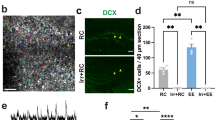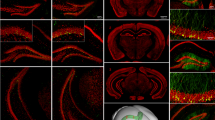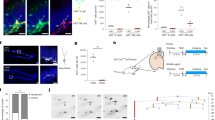Abstract
Neurogenesis occurs in the dentate gyrus of the hippocampus throughout the life of a rodent1–4, but the function of these new neurons and the mechanisms that regulate their birth are unknown. Here we show that significantly more new neurons exist in the dentate gyrus of mice exposed to an enriched environment compared with littermates housed in standard cages. We also show, using unbiased stereology, that the enriched mice have a larger hippocampal granule cell layer and 15 per cent more granule cell neurons in the dentate gyrus.
This is a preview of subscription content, access via your institution
Access options
Subscribe to this journal
Receive 51 print issues and online access
$199.00 per year
only $3.90 per issue
Buy this article
- Purchase on SpringerLink
- Instant access to full article PDF
Prices may be subject to local taxes which are calculated during checkout
Similar content being viewed by others
References
Altman, J. & Das, G. D. Autoradiographic and histologic evidence of postnatal neurogenesis in rats. J. Comp. Neurol. 124, 319–335 (1965).
Kaplan, M. S. & Hinds, J. W. Neurogenesis in the adult rat: electron microscopic analysis of light radioautographs. Science 197, 1092–1094 (1977).
Cameron, H. A. et al. Differentiation of newly born neurons and glia in the dentate gyrus of the adult rat. Neuroscience 56, 337–344 (1993).
Kuhn, H. G. et al. Neurogenesis in the dentate gyrus of the adult rat: age-related decrease of neuronal progenitor proliferation. J. Neurosci. 16, 2027–2033 (1996).
Rosenzweig, M. R. et al. Effects of environmental complexity and training on brain chemistry and anatomy. J. Comp. Physiol Psychol. 55, 429–437 (1962).
Altman, J. & Das, G. D. Autoradiographic examination of the effects of enriched environment on the rate of glial multiplication in the adult rat brain. Nature 204, 1161–1163 (1964).
Cummins, R. A. et al. Environmentally induced changes in the brains of elderly rats. Nature 243, 516–518 (1973).
Greenough, W. T. Experiential modificaiton of the developing brain. Am. Sci. 63, 37–46 (1975).
Meaney, M. J. et al. Effect of neonatal handling on age-related impairments associated with the hippocampus. Science 239, 766–768 (1988).
Rosenzweig, M. R. et al. Social grouping cannot account for cerebral effects of enriched environments. Brain Res. 153, 563–576 (1978).
Rosenzweig, M. R. Environmental complexity, cerebral change, and behavior. Am. Psychol. 21, 321–332 (1966).
Walsh, R. N. et al. The effects of environmental complexity on the histology of the rat hippocampus. J. Comp. Neurol. 137, 361–366 (1969).
Fiala, B. A. et al. Environmental complexity modulates growth of granule cell dendrites in developing but not adult hippocampus of rats. Exp. Neurol. 59, 372–383 (1978).
Cummins, R. A. et al. A developmental theory of environmental enrichment. Science 197, 692–694 (1977).
del Rio, J. A. & Soriano, E. Immunocytochemical detection of 5′-bromodeoxyuridine incorporation in the central nervous system of the mouse. Dev. Brain Res. 49, 311–317 (1989).
Sloviter, R. S. Calcium-binding protein (calbindin-D28k) and parvalbumin immunocytochemistry: localization in the rat hippocampus with specific reference to the selective vulnerability of hippocampal neurons to seizure activity. J. Comp. Neurol. 280, 183–196 (1989).
Walsh, R. N. & Cummins, R. A. Changes in hippocampal neuronal nuclei in response to environmental stimulation. Int. J. Neurosci. 9, 209–212 (1979).
Wimer, R. E. et al. The genetic organization of neuron number in the granule cell layer of the area dentata in house mice. Brain Res. 157, 105–122 (1978).
Cameron, H. A. et al. Regulation of adult neurogenesis by excitatory input and NMDA receptor activation in the dentate gyrus. J. Neurosci. 15, 4687–4692 (1995).
McEwen, B. S. Gonadal and adrenal steroids regulate neurochemical and structural plasticity of the hippocampus via cellular mechanisms involving NMDA receptors. Cell. Mol. Neurobiol. 16, 103–116 (1996).
Reynolds, B. A. et al. A multipotent EGF-responsive striatal embryonic progenitor cell produces neurons and astrocytes. J. Neurosci. 12, 4565–4574 (1992).
Palmer, T. D. et al. FGF-2-responsive neuronal progenitors reside in proliferative and quiescent regions of the adult rodent brain. Mol. Cell. Neurosci. 6, 474–486 (1995).
Craig, C. G. et al. In vivo growth factor expansion of endogenous subependymal neural precursor cell populations in the adult mouse brain. J. Neurosci. 16, 2649–2658 (1996).
Wainwright, P. E. et al. The effects of dietary fatty acid composition combined with environmental enrichment on brain and behavior in mice. Behav. Brain Res. 60, 125–136 (1994).
Pacteau, C. et al. Early rearing environment and dorsal hippocampal ibotenic acid lesions: long-term influences on spatial learning and alternation in the rat. Behav. Brain Res. 34, 79–96 (1989).
Gundersen, H. J. et al. The new stereological tools: disector, fractionator, nucleator and point sampled intercepts and their use in pathological research and diagnosis. Acta Pathol. Microbiol. Immunol. Scand. 96, 857–881 (1988).
West, M. J. New sterological methods for counting neurons. Neurobiol. Aging 14, 275–285 (1993).
Coggeshall, R. E. & Lekan, H. A. Methods for determining numbers of cells and synapses: a case for more uniform standards for review. J. Comp. Neurol. 364, 6–15 (1996).
Author information
Authors and Affiliations
Rights and permissions
About this article
Cite this article
Kempermann, G., Kuhn, H. & Gage, F. More hippocampal neurons in adult mice living in an enriched environment. Nature 386, 493–495 (1997). https://doi.org/10.1038/386493a0
Received:
Accepted:
Issue Date:
DOI: https://doi.org/10.1038/386493a0



